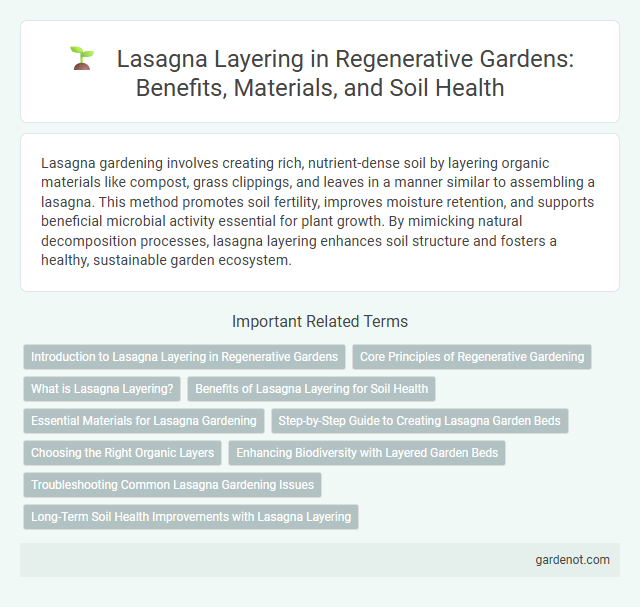Lasagna gardening involves creating rich, nutrient-dense soil by layering organic materials like compost, grass clippings, and leaves in a manner similar to assembling a lasagna. This method promotes soil fertility, improves moisture retention, and supports beneficial microbial activity essential for plant growth. By mimicking natural decomposition processes, lasagna layering enhances soil structure and fosters a healthy, sustainable garden ecosystem.
Introduction to Lasagna Layering in Regenerative Gardens
Lasagna layering in regenerative gardens involves creating nutrient-rich soil by stacking organic materials in alternating layers of carbon and nitrogen sources, such as dried leaves, compost, grass clippings, and kitchen scraps. This method enhances soil structure, promotes microbial activity, and improves moisture retention, leading to healthier plants and higher yields without synthetic fertilizers. By mimicking natural decomposition processes, lasagna layering builds fertile, sustainable garden beds that support long-term ecosystem resilience.
Core Principles of Regenerative Gardening
Lasagna layering in regenerative gardening harnesses the core principles of soil health, biodiversity, and nutrient cycling by creating stacked organic layers that mimic natural ecosystems. This technique promotes composting in place, reducing waste and enhancing microbial activity essential for nutrient-rich soil. By layering materials such as cardboard, compost, straw, and green waste, gardeners improve moisture retention and soil structure, fostering sustainable plant growth without synthetic inputs.
What is Lasagna Layering?
Lasagna layering in regenerative gardening is a no-dig, composting technique that builds fertile soil by stacking organic materials in layers, mimicking natural forest floor processes. This method involves alternating brown (carbon-rich) and green (nitrogen-rich) materials such as leaves, grass clippings, kitchen scraps, and cardboard to create a nutrient-dense bed that enhances soil structure and microbial activity. Over time, the layers break down to produce rich humus, supporting healthy plant growth while conserving water and reducing weeds.
Benefits of Lasagna Layering for Soil Health
Lasagna layering enhances soil health by creating a nutrient-rich environment through decomposing organic materials like leaves, compost, and grass clippings. This method improves soil structure, increases moisture retention, and boosts microbial activity essential for nutrient cycling. Over time, lasagna layering fosters fertile, well-aerated soil that supports robust plant growth and sustainable gardening.
Essential Materials for Lasagna Gardening
Essential materials for lasagna gardening include alternating layers of carbon-rich brown materials such as dried leaves, straw, and shredded paper with nitrogen-rich green materials like grass clippings, vegetable scraps, and coffee grounds. Incorporating compost, manure, and rich soil enhances microbial activity and nutrient availability for plant growth. Moisture retention is improved by adding newspaper or cardboard layers that also suppress weeds, creating a fertile, self-sustaining garden bed.
Step-by-Step Guide to Creating Lasagna Garden Beds
To create lasagna garden beds, start by laying down a base of coarse organic materials such as cardboard or newspaper to suppress weeds and retain moisture. Follow with alternating layers of nitrogen-rich green materials like grass clippings and kitchen scraps, and carbon-rich brown materials such as dried leaves, straw, or shredded paper, building up 12 to 18 inches in total thickness. Water each layer thoroughly to promote microbial activity, then allow the bed to decompose for several weeks before planting nutrient-rich, sustainable crops.
Choosing the Right Organic Layers
Selecting the right organic layers for a lasagna garden maximizes soil fertility and moisture retention. Use nitrogen-rich materials like composted kitchen scraps and fresh grass clippings combined with carbon-rich layers such as dried leaves, straw, and shredded newspaper. Layering these elements in thin, alternating strata creates a balanced, nutrient-dense environment that accelerates decomposition and supports robust plant growth.
Enhancing Biodiversity with Layered Garden Beds
Lasagna layering in regenerative gardens boosts biodiversity by creating diverse microhabitats within each garden bed, supporting a range of beneficial insects, microorganisms, and plants. This technique uses alternating organic materials like compost, straw, and leaves to enrich soil health and foster robust microbial activity that enhances nutrient cycling. Layered beds improve water retention and root penetration, encouraging a thriving ecosystem that sustains resilient plant growth and natural pest control.
Troubleshooting Common Lasagna Gardening Issues
Lasagna gardening often faces challenges like uneven decomposition, pest infestations, and poor soil aeration. To troubleshoot, balance green and brown organic layers to promote proper microbial activity and prevent nitrogen depletion. Incorporate coarse materials such as straw or shredded cardboard to enhance airflow and deter pests, ensuring healthy soil formation for vigorous plant growth.
Long-Term Soil Health Improvements with Lasagna Layering
Lasagna layering in regenerative gardening enhances long-term soil health by creating nutrient-rich, organic layers that promote microbial diversity and improve soil structure. This method steadily increases soil fertility through the decomposition of alternating layers of carbon-rich and nitrogen-rich materials. Over time, it boosts moisture retention, reduces erosion, and supports sustainable plant growth without the need for synthetic fertilizers.
Lasagna layer Infographic

 gardenot.com
gardenot.com